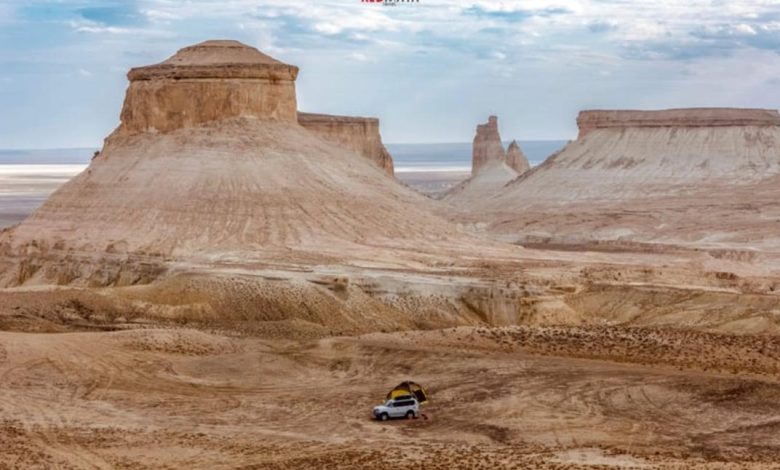
By : Dr. Abdel Rahim Abdel Wahed
Jordan Daily – At first glance, Western Kazakhstan seems a lot like Arabia. Oil, camels, desert. But this paltry lexicon is enriched with a very specific, local vocabulary, it is the land of 362 saints and historical monuments
The Mangistau region, located in south western Kazakhstan, is known for a myriad of historical sites. Though the region is better known for its vast oil and gas onshore and offshore reserves, it is also known among locals as the land of 362 saints attracting pilgrims.
The lack of infrastructure in the deserts of West Kazakhstan means this is a place for explorers with their own expedition-grade transport. Barring that, you will likely need a decent budget to organise a tour or rent a car if you want to see the attractions of the hinterland.

Its name was Mangystau, like the rest of the region, but also the small town next to Aktau, the capital of that region and an important port on the Caspian Sea. The area with these colorful, strange geological formations that belongs to the Ustyurt National Park and that once formed the bottom of the prehistoric Tethys Ocean is also referred to as Mangystau.
It is estimated that about 700 000 tourists visited Mangystau in 2024 and the amount is expected to continue to increase. Kazakh authorities have also noticed the potential of tourism in the area and are implementing projects to improve the tourism infrastructure in the area.
Domestic Tourists
Inbound and domestic tourists in the West Kazakhstan Region increased by 18% compared to the first nine months of 2023. Investments in tourism totalled US$28.4 million, a 47% growth, with a pool of 14 tourism projects worth US$49 million for 2024-2026.
Mangystau tours mostly start and end in Aktau and include most of the time extensive periods of driving in a 4WD car in desert-like conditions, far away from any services. Depending on the time you have available, Mangystau offers sights from few days to more than a week.
The accommodation during Mangystau tours is mostly in tents and sometimes in yurts or guesthouses. The food served during Mangistau tours will be mostly cooked at place as there are very few villages or other locations serving food where the best Mangistay sights are located.

The Treasure Peninsula, this is how people call one of the richest areas of Kazakhstan – Mangistau Region. This land is rich in oil, gas, construction materials, various ores and minerals. It is also true that the present-day Mangistau is called the land of tourism and recreation resources with rich cultural heritage.
Experience a comprehensive that unveils the vast natural wonders of Mangystau, Journeying by jeep, you’ll discover an array of majestic sites: from the mysterious stone balls of Torysh to the imposing Sherkala Mountain, the captivating valley of castles Airakty, and the awe-inspiring Bozzhyra valley with its vertigo-inducing viewing platforms. This tour is an incredible way to explore the diverse and stunning landscapes of the region.
What to see in Mangystau?
Located east of the Caspian Sea, bordering Uzbekistan on the east and Turkmenistan on the south, the territory is diverse in landscapes from Caspian lowland, plateaus, such as Ustyurt, Mangyshlak and Kendirli-Kayasan to Aktau and Karatau mountains and desert lands, there are:
Chalky mountains of Bozjyra (also spelled as Boszhira) are two sharp peaks, from the base of which you can admire the quaint castle wall.
The ‘Valley of Balls’ – a valley covered with huge spherical rock formations striking by their unearthly appearance.
The Mount Sherkala- snow-white rock, which changes its appearance, if you go around it; Kapamsay Canyon, where you can see a real workshop, where tools during the Stone Age era were made; Jygylgan – ‘the fallen ground, etc.
The underground mosques – Beket Ata, Shakpak Ata, Shopan Ata, Sultan Epeand others, which attract many believers and travelers all over Kazakhstan and the world.
The Ustyurt Plateau, a clay and stony desert occupying an area of almost 200,000 square kilometres, is a must visit sight in one’s journey in the region.
Shakpak Ata was a student of Khoja Ahmed Yassawi, prominent Sufi master. The mosque is located in the Tub-Karagan district and is considered most ancient architectural monument in the western region of Kazakhstan dating back to the 9th-10th centuries.
Situated in 18 km from Shetpe, Akmish area enchants tourists not only with its beauty but also with its historical attractions of ancient Kizil-Kala (which stands for a ‘red town’ in Kazakh).

Three kilometres from Akmishsay will bring tourists to the picturesque canyons Samal and Sazanbay. Hanga-Baba Tract, another attractive place, is situated in 30 km from Fort-Shevchenko.
The Shopan – Ata Necropolis and underground mosque is one of the sacred places to the pilgrims of the Mangystau area, and it is considered an exemplary representation of Sufi architecture.
• “Bozjyra is a magnificent creation of weathering and erosion, part of the Ustyurt Plateau and includes vast clay deserts, limestone mountains, and sharp cliffs over 200 meters high.
• The Ustyurt Plateau is said to have been the bottom of the ancient Tethys Ocean, and there was a constant accumulation of precipitation on it: clay, sand, various organisms. Therefore, it is not surprising that landscapes change their colors at different times of the day.
• “Kyzylkup (Tiramisu) tract is smooth low hills consisting of rocks of various colors that alternate with each other, creating a fascinating spectacle. The color of the layers is given by impurities of various minerals.
• The Aktolagai mountains are just across the border with Aktobe region. If you have the means to get there, this is a fascinating landscape built with fossils from a long-gone sea. It’s a 2-day trip if you are returning to Atyrau.
• Aqtau: It is another unexciting place fuelled by oil money. It’s mainly known to travelers as the place where the ferry across the Caspian Sea from Azerbaijan arrives. Most travelers then take the desert road straight into Uzbekistan.
• Ustyurt plateau: Mangystau has a Turkmen influence, and not only in the landscape. Many Kazakhs in, for instance, Zhanaozen and Beyneu, are recent immigrants from Turkmenistan.
• Uralsk: Uralsk (Oral in Kazakh) is the oldest city in Kazakhstan, a trade hub along the Ural River.
• Aktyube Region is one of the most significant indus trial areas of Kazakhstan. It occupies the area of ap proximately 300,000 sq. km.
• Atyrau Region is the kingdom of steep 400-m slopes (chinks) and absolutely white, perfectly shaped stone spheres of about 2 m in diameter.

